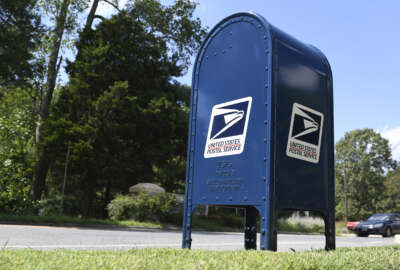Federal judge dismisses charge against USPS employee for carrying gun at work for self-defense
USPS tells its employees that the U.S. District Court's recent ruling 'does not change the organization’s policy' prohibiting firearms in post offices.
UPDATE: This story was updated on Jan. 19 at 1 p.m. to include a Postal Service message telling employees that the U.S. District Court’s recent ruling ‘does not change the organization’s policy’ prohibiting firearms in post offices.
A federal judge is challenging gun restrictions in post offices across the country.
U.S. District Judge Kathryn Kimball Mizelle, in a ruling last Friday, first reported by Reuters, dismissed a criminal charge against a Postal Service employee who brought a concealed handgun into the post office where he worked.
Mizelle said she dismissed the charge of illegally possessing a gun in a federal facility, because it violates the USPS employee’s Second Amendment right to bear arms.
A USPS spokesman said the court’s ruling more broadly, “determined that a federal statute was unconstitutional which makes it a crime to knowingly bring a firearm or other dangerous weapon into a federal facility.”
Emmanuel Ayala, a Postal Service semi-truck driver in Tampa, Florida, was arrested in September 2022 for bringing a concealed handgun into a post office where he worked.
According to court documents, Ayala walked into an employee-only section of the post office, wearing a fanny pack with a concealed handgun.
After Ayala clocked in, agents with the USPS Office of Inspector General stopped and tried to detain him. Court documents state Ayala fled, but was later arrested by officers from the Tampa Police Department.
Ayala’s attorney, Stephen Consuegra, said his client obtained a concealed weapons permit, and that Ayala carried his gun “primarily for self-defense while he’s on the job and driving on the roadways.”
“Most of the time he leaves his fanny pack and concealed firearm inside his parked car off site and grabs it after he picks up his semi-truck for his daily route,” Consuegra wrote. “But from time to time, he carries his concealed firearm inside his fanny pack for extra protection on the short walk to work.”
Friday’s ruling in the U.S. District Court for the Middle District of Florida refers back to the Supreme Court’s ruling in New York State Rifle & Pistol Association v. Bruen, a 2022 case that gave individuals broad authority under the Second Amendment to carry a gun outside their homes for self-defense.
The Supreme Court’s ruling still allows for banning guns in some sensitive places, including government facilities, but the restrictions must be “consistent with this nation’s historical tradition of firearm regulation.”
“The Supreme Court has been clear: the government must point to historical principles that would permit it to prohibit firearms possession in post offices,” Mizelle said.
Justice Department attorneys argued a government building “has been deemed a sensitive place that can ban the carrying of firearms while not violating an individual’s Second Amendment rights and is consistent with the nation’s historical tradition of firearm regulation.”
However, the judge ruled the federal government failed to “affirmatively prove” that regulating firearms in post offices is “part of the historical tradition that delimits the outer bounds of the right to keep and bear arms.”
“There is no evidence of firearms being prohibited at post offices, specifically, or of postal workers being prohibited from carrying them, at the time of the founding,” Mizelle wrote.
USPS spokesman Jim McKean told Federal News Network that the agency is currently reviewing the U.S. District Court’s ruling.
“The Postal Service regulates its facilities for the safety, economy, and convenience of customers and employees engaged in postal business nationwide. One Postal Service regulation in this regard prohibits the possession or storage of firearms on real property under the charge and control of the Postal Service, and that regulation was upheld by a federal court of appeals in 2015,” McKean said. “We are evaluating the interplay between our regulation and the recent interpretation of the broader federal criminal statute and determining the appropriate next steps.”
USPS, in a message to its employees on Jan. 18, said the U.S. District Court’s recent ruling “does not change the organization’s policy” on firearms in post offices.
“Employees are reminded that carrying or storing firearms, other dangerous or deadly weapons, or explosives — either openly or concealed — on USPS property is prohibited and can result in discipline up to and including removal from the Postal Service, as well as potential prosecution,” the message states. “This prohibition includes storing firearms in vehicles that are parked on postal property.”
The Justice Department argued before the court that Ayala “cannot show that the Second Amendment prevents the government from prohibiting its employees from bringing guns to work.”
Mizelle, in her ruling, said USPS prohibiting employees from bringing weapons into the post office is a separate matter from her dismissing Ayala’s criminal charge of illegally possessing a gun in a federal facility.
“I do not know whether the United States also fired him or took any other disciplinary action for carrying a firearm in violation of a condition of his employment. Whether such a condition of employment would comport with the Second Amendment has gone entirely unbriefed and remains wholly irrelevant. As it stands, the criminal prosecution is completely divorced from his status as a postal employee,” she wrote.
Federal News Network has also reached out to the Justice Department and Ayala’s attorney for comment.
Mizelle dismissed a charge of Ayala illegally possessing a gun in a federal facility, but declined to dismiss a charge of forcibly resisting arrest.
Consuegra said the OIG agents “never identified themselves as being affiliated with OIG, they never stated their business with Mr. Ayala, and they never informed him that he was under investigation for committing any crimes on USPS property.”
“They were complete strangers to Mr. Ayala … A reasonable person in Mr. Ayala’s shoes would have fled in the same manner and surrendered when he or she saw local police in full uniform,” he wrote.
Federal law prohibits non-authorized personnel from possessing a firearm in a federal facility.
The U.S. Code defines a federal facility as “a building or part thereof owned or leased by the federal government, where federal employees are regularly present for the purpose of performing their official duties.”
Mizelle, however, ruled that “a blanket restriction on firearms possession in post offices is incongruent with the American tradition of firearms regulation.”
Mizelle wrote that gun bans in post offices and “relevantly similar federal buildings” did not appear until the mid-twentieth century — over 170 years after the country’s founding.
“The United States fails to meet its burden of pointing to a historical tradition of firearms regulation justifying Ayala’s indictment,” she wrote.
The Justice Department argued that laws dating back to the founding of the U.S. prohibit arms in legislatures, polling places and courthouses.
But Mizelle said that prohibition was overly broad, and that a blanket firearm ban in all federal facilities “captures everything from the White House to toll booths in national parks to Social Security Administration buildings.”
“At some point, when twenty-eight percent of land in the United States is owned by the federal government and many ordinary activities require frequenting a ‘federal facility,’ the government’s theory would amount to a nullification of the Second Amendment right altogether,” she wrote.
Mizelle wrote that “since the Post Office’s creation, mail carriers have faced the risk of violence.”
“The federal government never sought to ban firearms to protect employees or secure mail delivery. In fact, when mail train robberies became a growing threat in the early twentieth century, the Postmaster General armed railway mail clerks with ‘government-issued pistols’ from World War I,” the judge wrote.
The Postal Service, in recent years, has been dealing with an uptick in crime, including armed robberies of letter carriers.
The Postal Inspection Service, in its latest annual report to Congress, said it made 1,258 mail-theft arrests in fiscal 2022, and that 1,188 of those cases resulted in convictions. That same year, USPIS made 100 robbery arrests, which led to 68 convictions.
Meanwhile, USPS and the Postal Police Officers Association (PPOA) have been locked in a protracted legal battle for years to determine what jurisdiction, if any, postal police officers have beyond USPS facilities, and whether they have the authority to patrol delivery routes in high-crime areas to protect letter carriers.
Copyright © 2024 Federal News Network. All rights reserved. This website is not intended for users located within the European Economic Area.
Jory Heckman is a reporter at Federal News Network covering U.S. Postal Service, IRS, big data and technology issues.
Follow @jheckmanWFED






